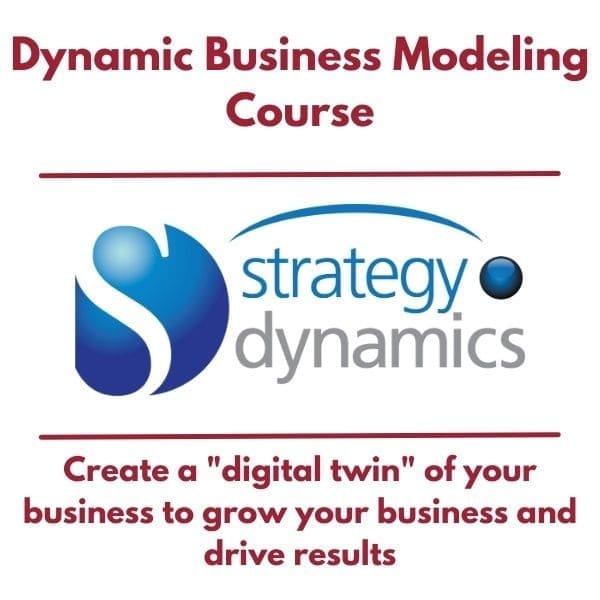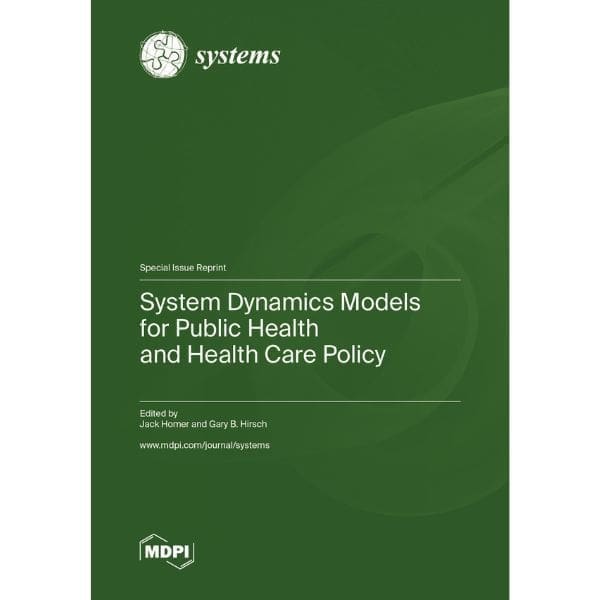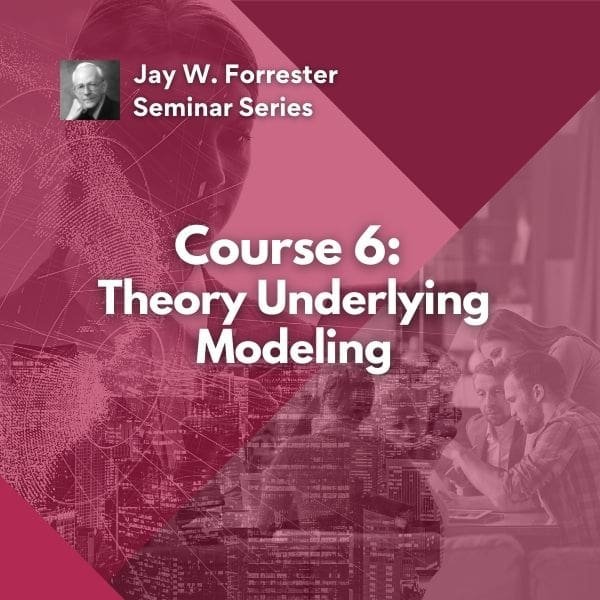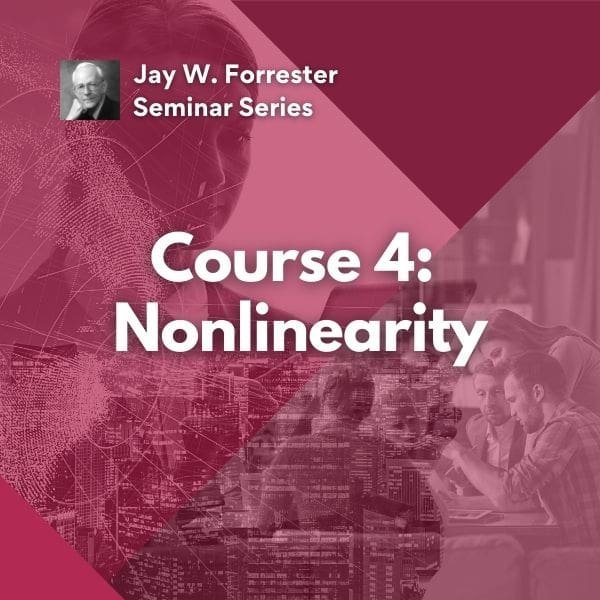Full Course: £950 | Essentials Course: £350 | Members get a 20% discount
This Dynamic Business Modeling course shows you how to create a “digital twin” of your business that offers quantified, time-based, visual simulations of how the business actually works, with all the inter-dependencies, tipping points and feedbacks we know are out there.
Description
Strategy Dynamics has made this on-demand, online course "Dynamic Business Modeling" available to you to show you how to create a “digital twin” of your business that offers quantified, time-based, visual simulations of how the business actually works, with all the inter-dependencies, tipping points and feedbacks we know are out there. Build powerful living models of plans or issues in half the time of using spreadsheets.
You will see how to get reliable models, much faster, so you can finally focus on your plans or issues, rather than spreadsheet problems. Then you can use your time to grow the business - and your career!
What you will learn:
- Modeling Performance Over Time: You’ll learn how to visualise the changing performance of your business as it actually works - not with linear assumptions. So you can see the impact of your decisions in a safe space before implementing them in the real world. This will help you present unambiguous recommendations, with confidence.
- Factors Driving Performance Outcomes: You will learn to model how that changing performance depends on changes happening to key resources in the business, like customers, staff, products, and capacity. Knowing just this can help you see deeper insights and make powerful recommendations.

- How resources accumulate: You will understand a critical real-world phenomenon - how quantities of customers, staff, products, and capacity build up and deplete over time. Understanding these mechanisms helps you avoid imbalances in the system, and understand delays between decisions and their intended impact.
- Connectedness, feedback, and growth: For the first time since using spreadsheets, you will learn how to model the interdependencies between business resources. You will see (yes, literally, see!) how feedback can accelerate growth of customers and sales. How resource-limits can strangle that growth, or drive a decline. How the entire business develops and performs over time.
- Build a complete model from scratch: You will learn how to build a simple but complete dynamic business model from scratch for a common example. You will follow me step-by-step as you build a business model for a table-service restaurant, including its customers, product range, staff, sales, service quality, profits, and more.
- Build a model to tackle any issue: Using this course, you can create dynamic business models to find solutions to pressing business problems that you are dealing with right now. And develop and test robust plans to tackle big challenges or opportunities.
- Build living plans for any function: Behind your plans for the whole business, you need plans for all the functions that make it up. You need a marketing strategy. An HR staff development plan. An IT strategy, and so on. And these need continual updating to keep up with changes happening through the business and in the outside world.
- Selling Dynamic Business Models: Once you learn to use dynamic business models, you will find it hard to go back to using spreadsheets, or any other approach. We explain how to pitch dynamic business modeling to your management so you can continue to deliver the value it offers, continue to use the software, and be seen as the go-to expert for any issue they want to tackle.
- By the end of the course, you will see how it is possible to create a “digital twin” of your business that behaves just like the real world. So you can run what-if tests and scenarios with high success rates.
- Class 1: Specifying your desired performance outcomes
-
- Creating time-charts of past performance and desired future outcomes.
- Past performance tells you how the business works, and is already driving future progress (customers won last year still drive sales today).
- Choosing the right time-scale and time-units for a model.
- Adding simple calculations
- How to explore performance with the model.
- Useful tricks and modeling principles.
- Creating time-charts of past performance and desired future outcomes.
- Class 2: How resources drive results
- The importance of resource “Stocks” (things that accumulate over time - like customers, staff, cash ...), both in the real world and in your models.
- These resource-stocks drive performance at all times - today's customers drive today's sales; today's staff drive the capacity to get things done, and they drive labour costs...
- Stocks, Decisions, and External Factors drive performance.
- Standard customers-to-sales relationships, and standard supply-side relationships (e.g. staff drive service capacity and cost).
- What if your objective is not for a performance result? (e.g. "Hit 2 million customers by year-end").
- Using "lookup" relationships when normal calculations do not apply (e.g. how many customers are won as marketing increases)
- Modeling separate groups or segments of customers or staff
- The importance of resource “Stocks” (things that accumulate over time - like customers, staff, cash ...), both in the real world and in your models.
- Class 3: How customers, staff, products, and capacity accumulate and deplete.
- How “flows” drive changes to customers, staff, and other resources* - new customers/month, staff lost/week...
- If resource-stocks drive performance at all times, then these "flows" of resource are the key factors that change They are the key strategy levers.
- Where flows of resources come from - and go to - g. customers won from a limited potential market.
- A common, powerful structure for growth of customers and sales.
- Calculating period-endand average values of resource-stocks
- Adding delays to when flows happen (g. 3-month staff training).
- Modeling sales of durable products and one-time services.
- How to model stock-flow structures for groups or segments.
- How “flows” drive changes to customers, staff, and other resources* - new customers/month, staff lost/week...
- Class 4: How resources work as a system, driving performance.
- Interdependence creates the core business system - its "strategic architecture."
- How existing Stocks drive changes to other Stocks - sales staff win customers; too few service staff drives customer losses...
- Decisions and External Factors also drive flow rates - we decide the hiring rate; competitors' prices affect our customer growth).
- How feedback may accelerate growth, or hold it back.
- Modeling intermediaries (retailers or dealers).
- Multi-stockfeedback - winning consumers helps a brand win retailers ... which wins more consumers.
- How to automate decisions and policies.
- Course wrap-up.
- Review and next steps
- "Selling" dynamic models.
- How extension structures increase the contribution and power of dynamic models.
- Developing your skills.
- Review and next steps
- Text Lessons
- “Follow Me” Videos
- PDF Slides
- Working Models
- Self-Test Quizzes
- Bonus Lesson
- The essential model principles
- “Follow Me” demos
- Build a complete business model
- Discussion list for your questions
- Full refund on upgrade to full course





